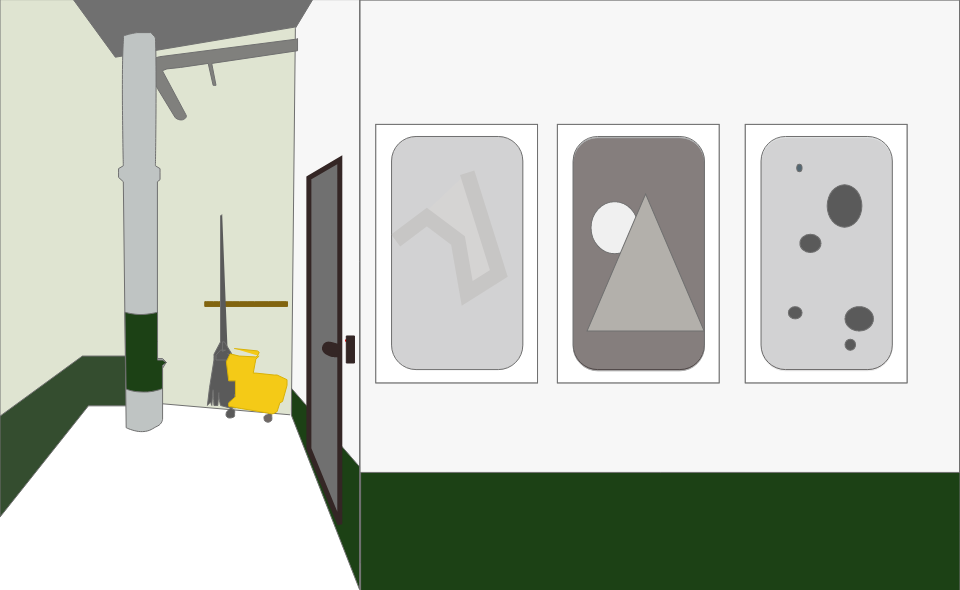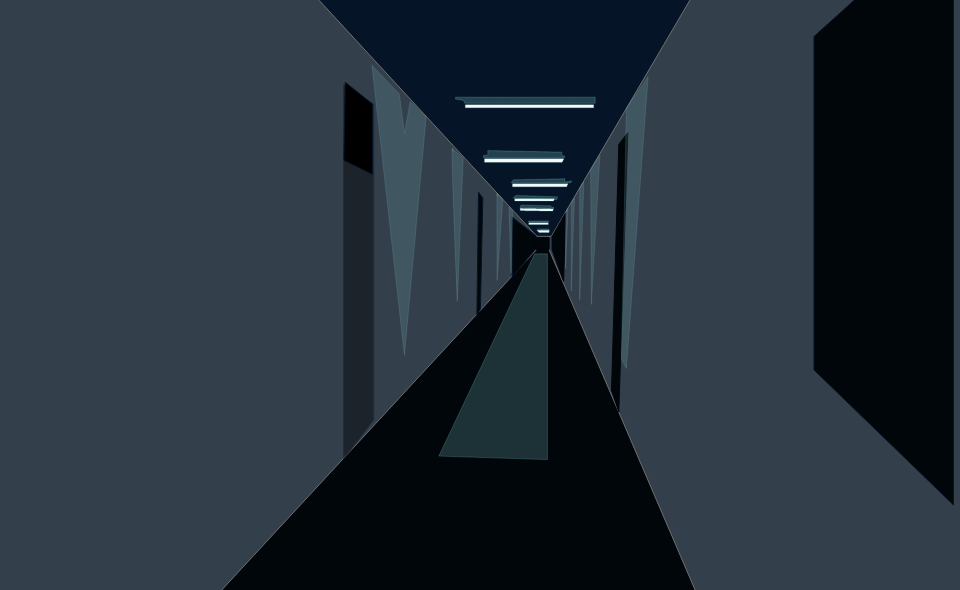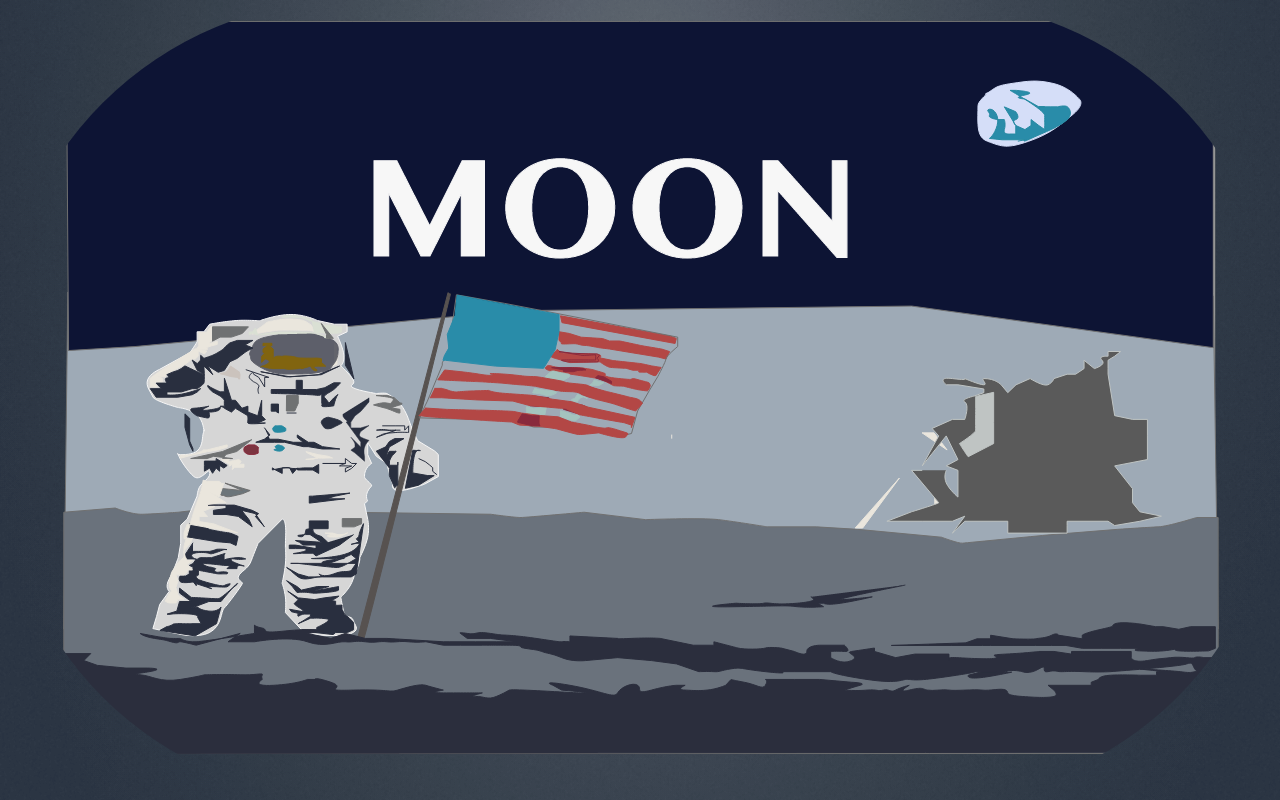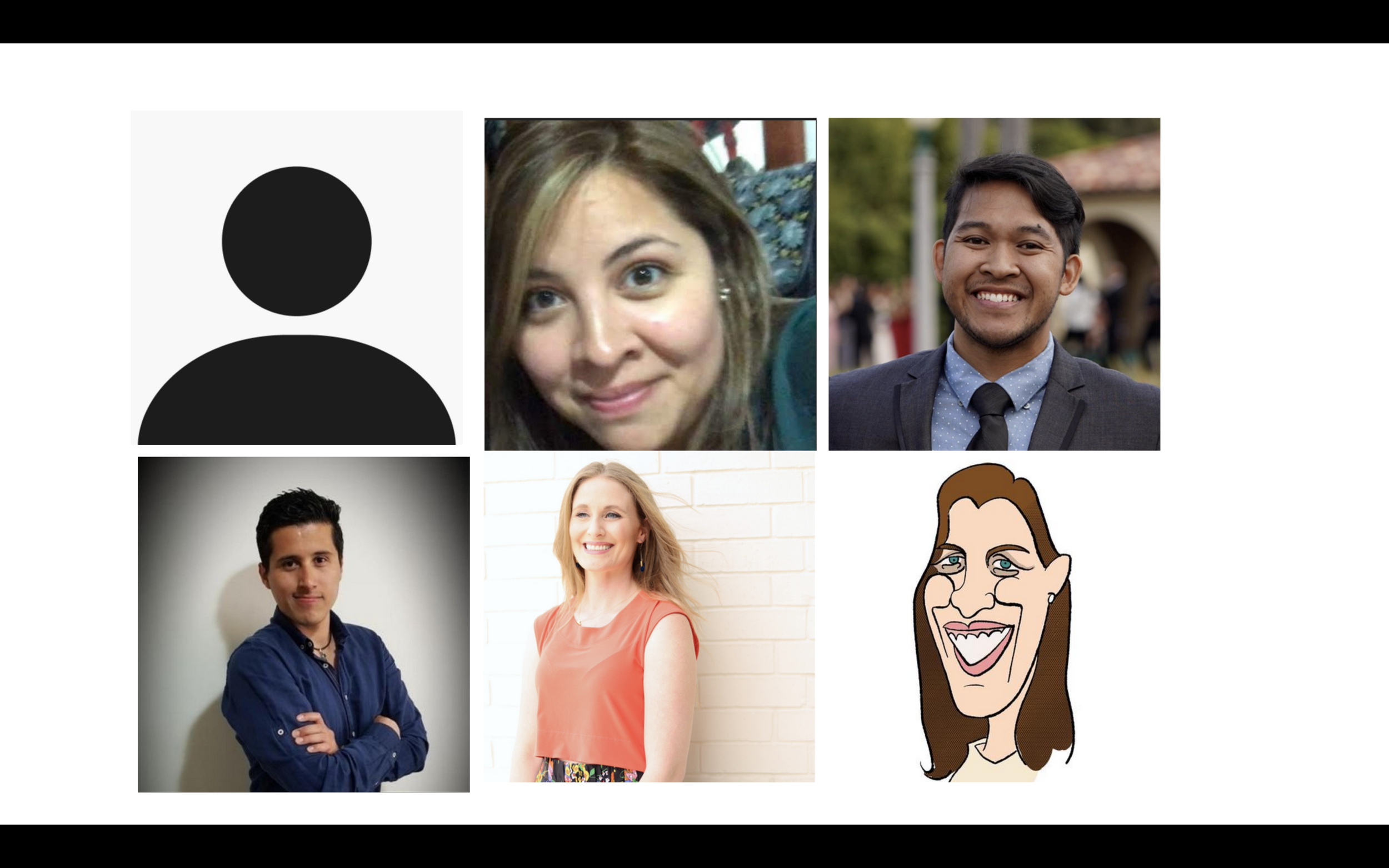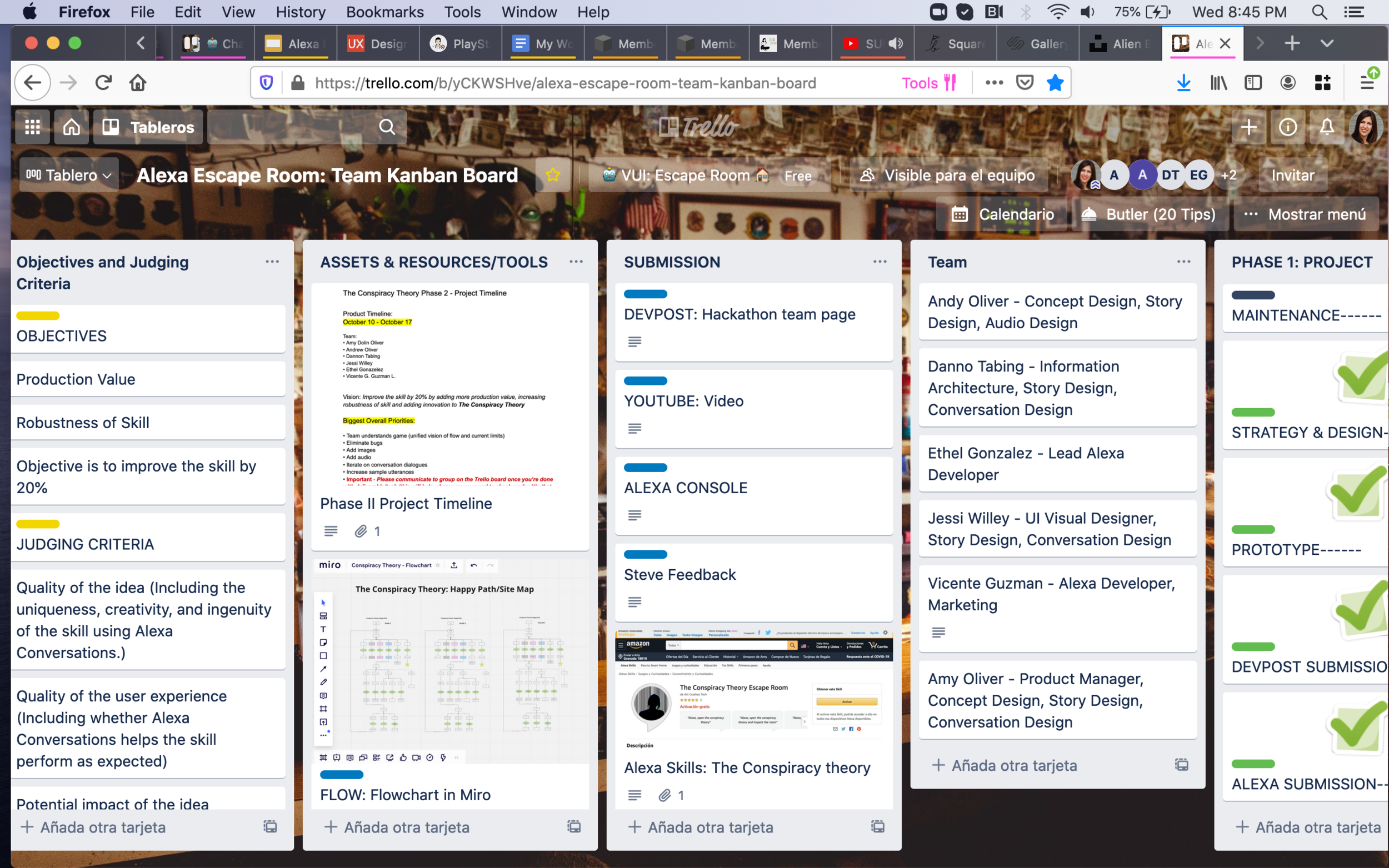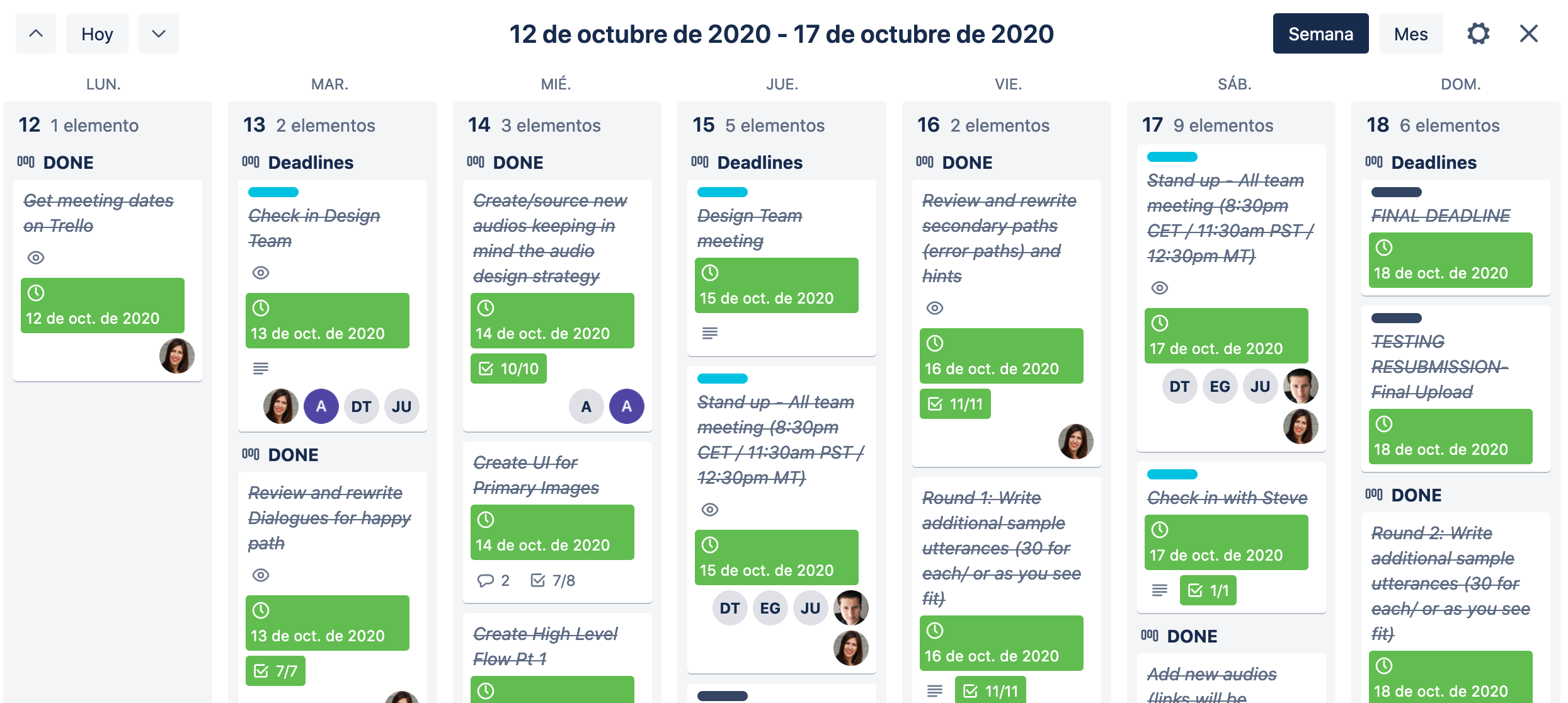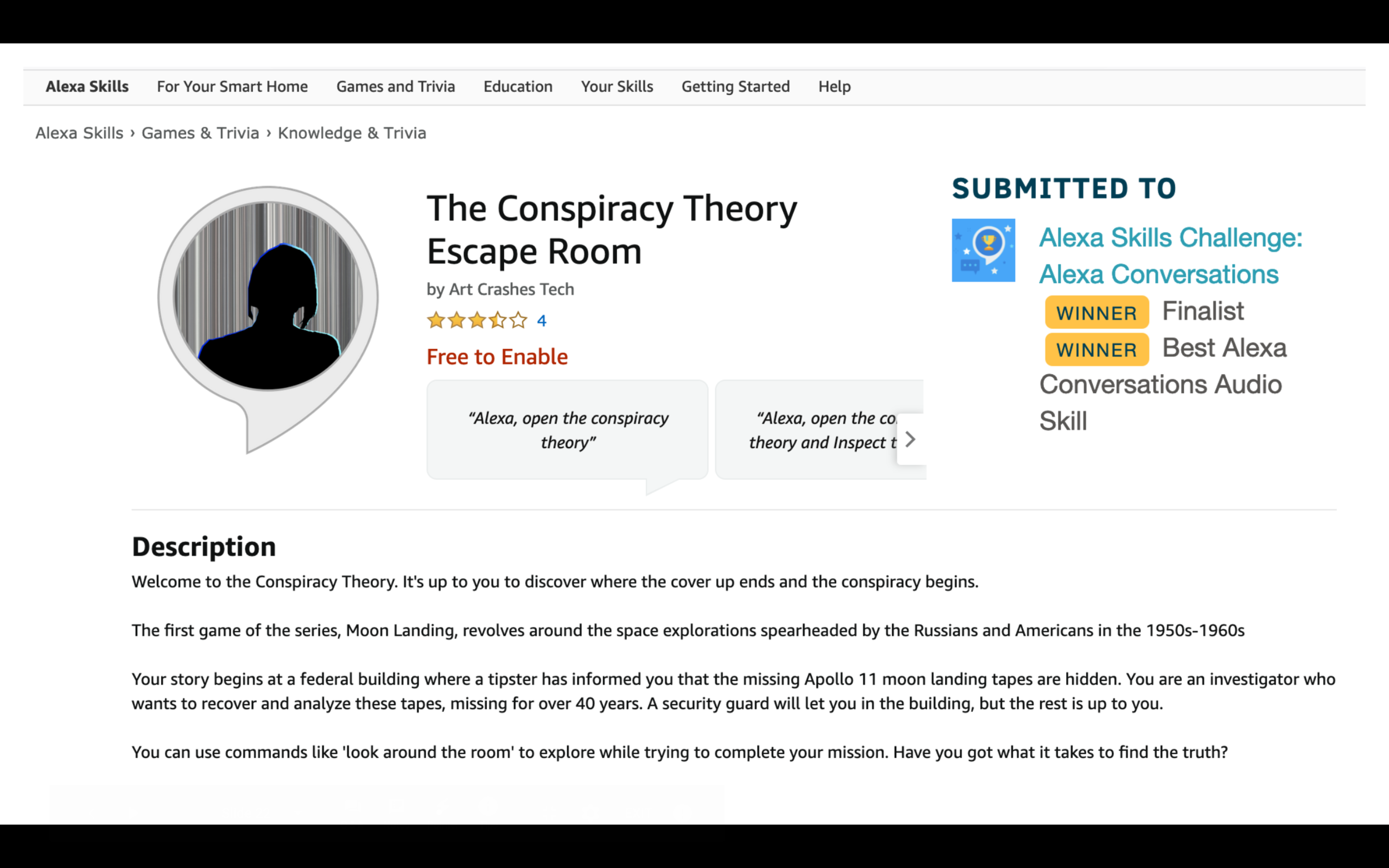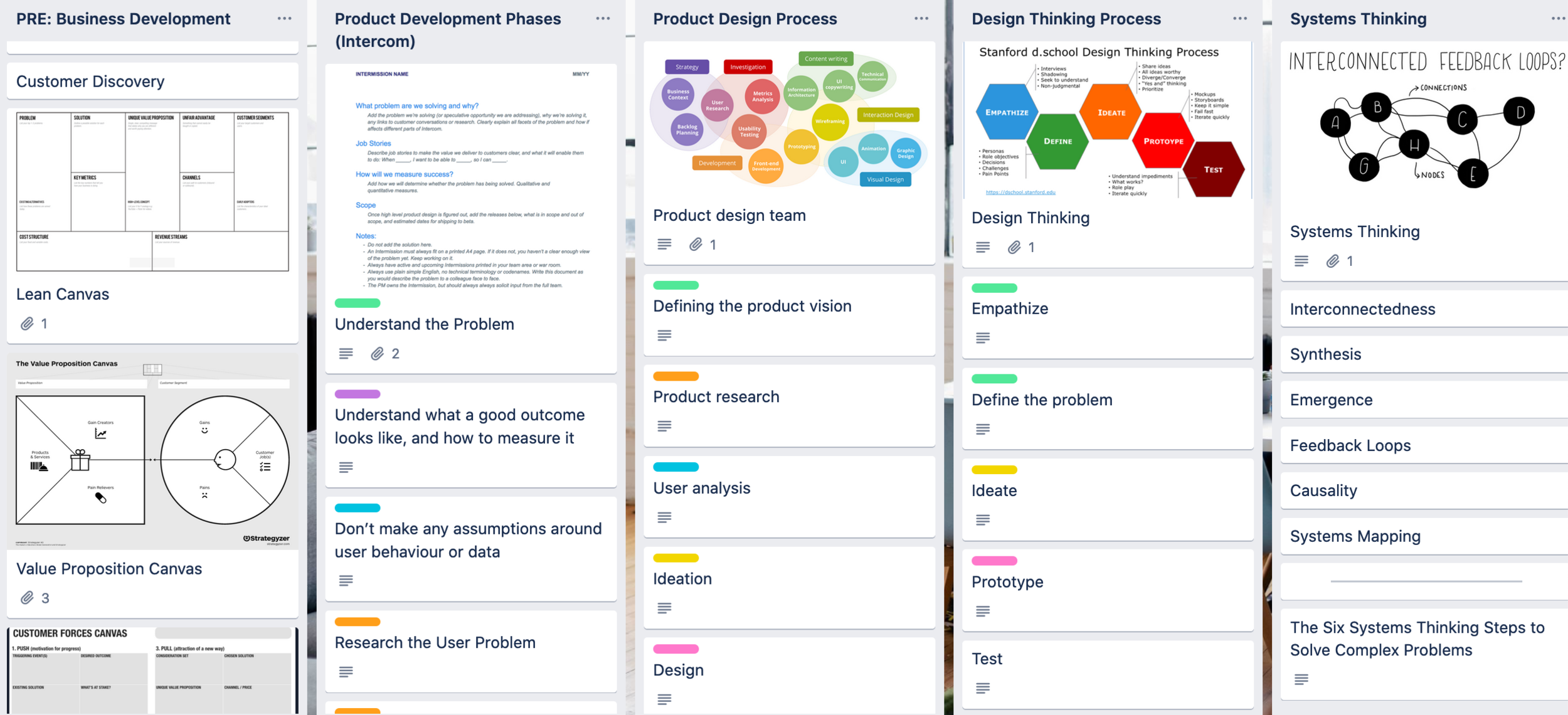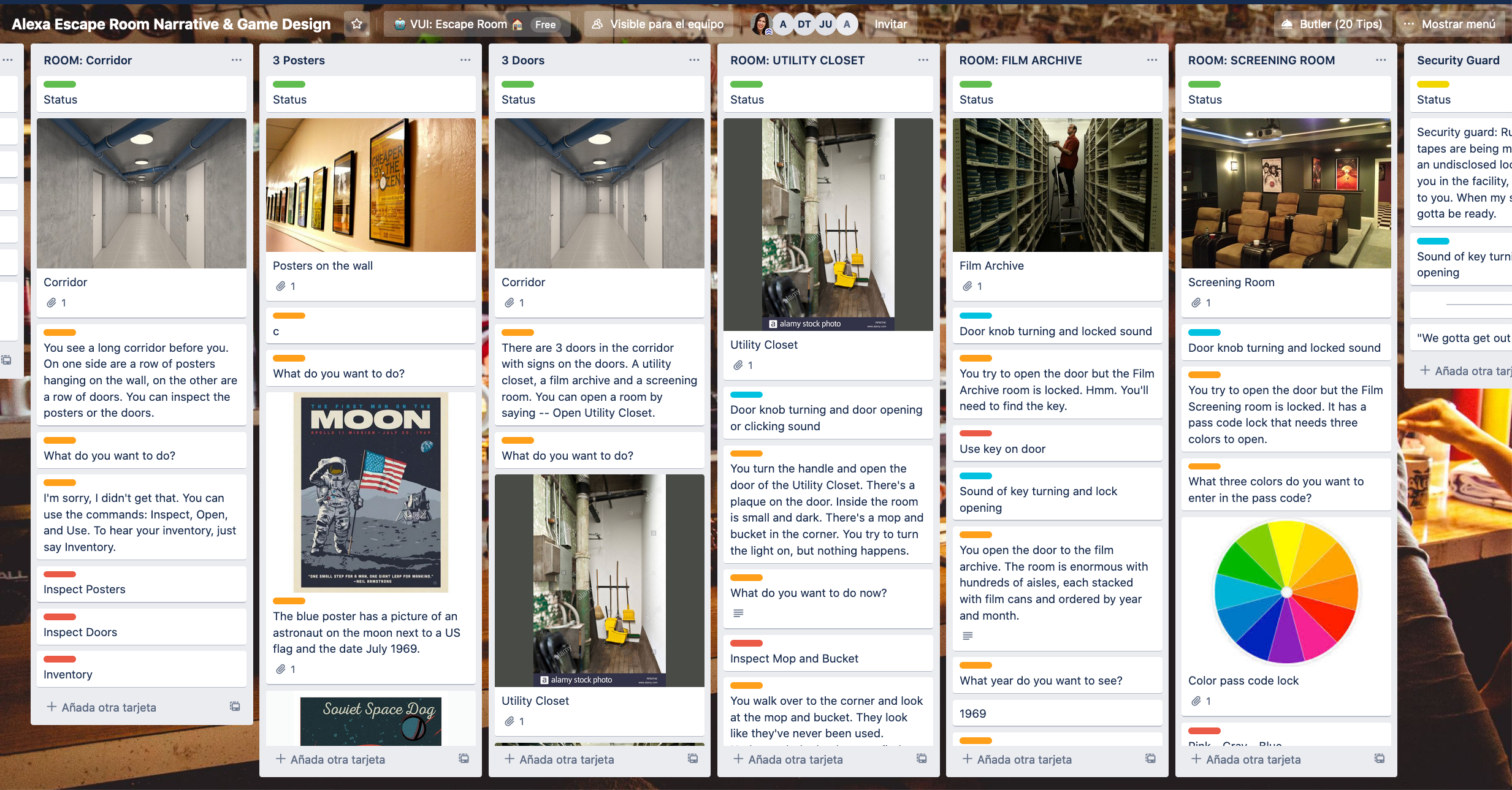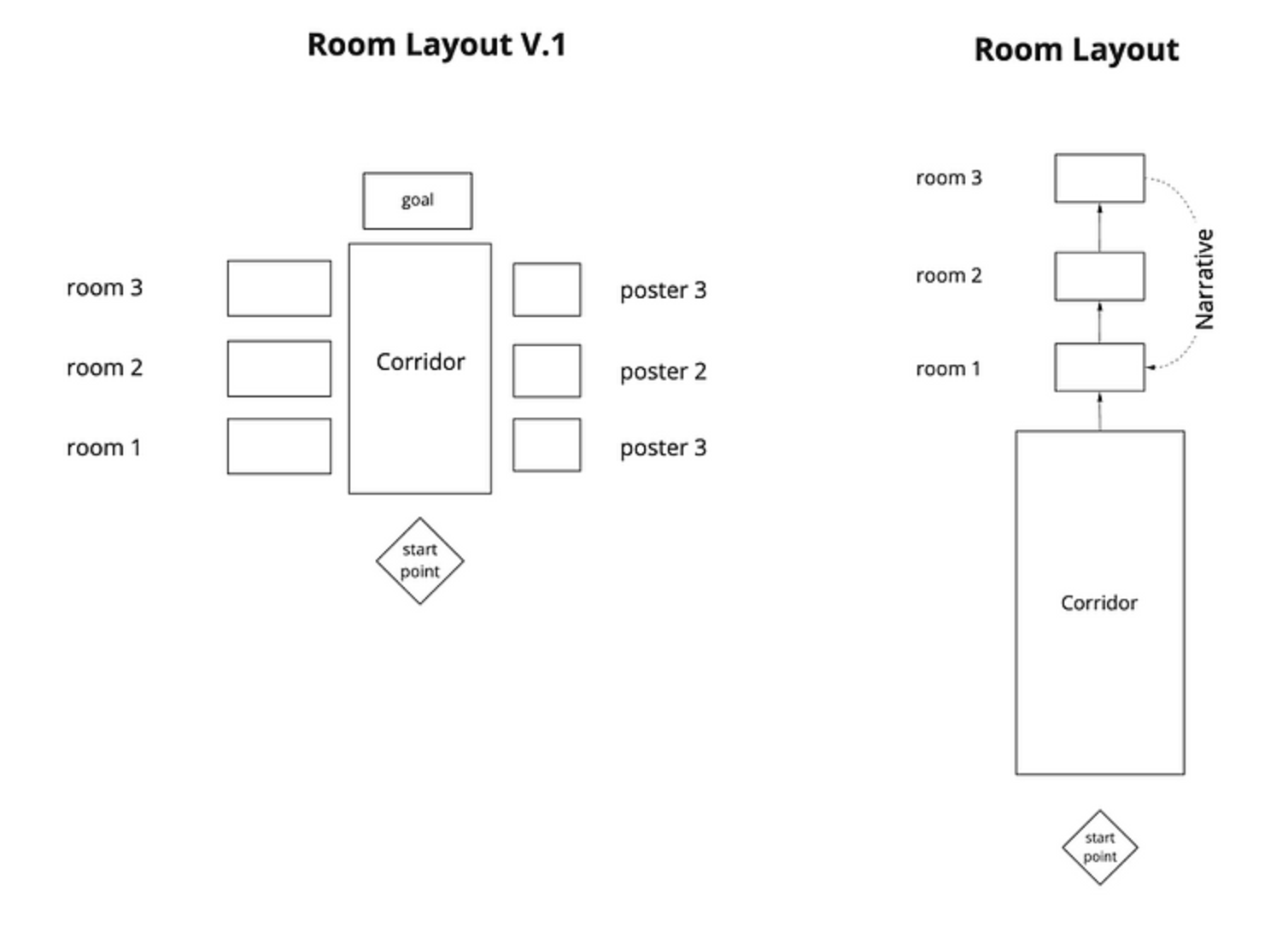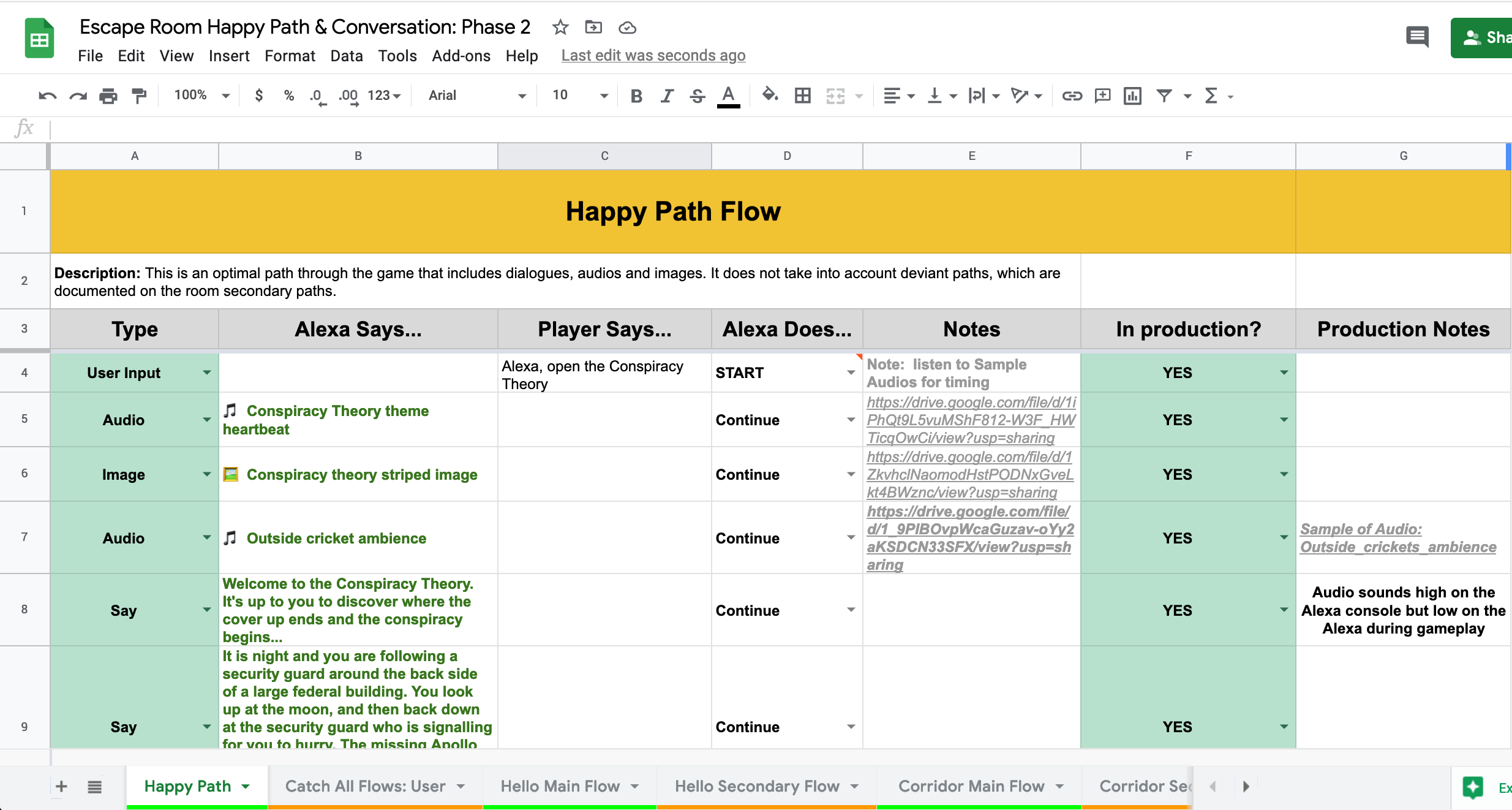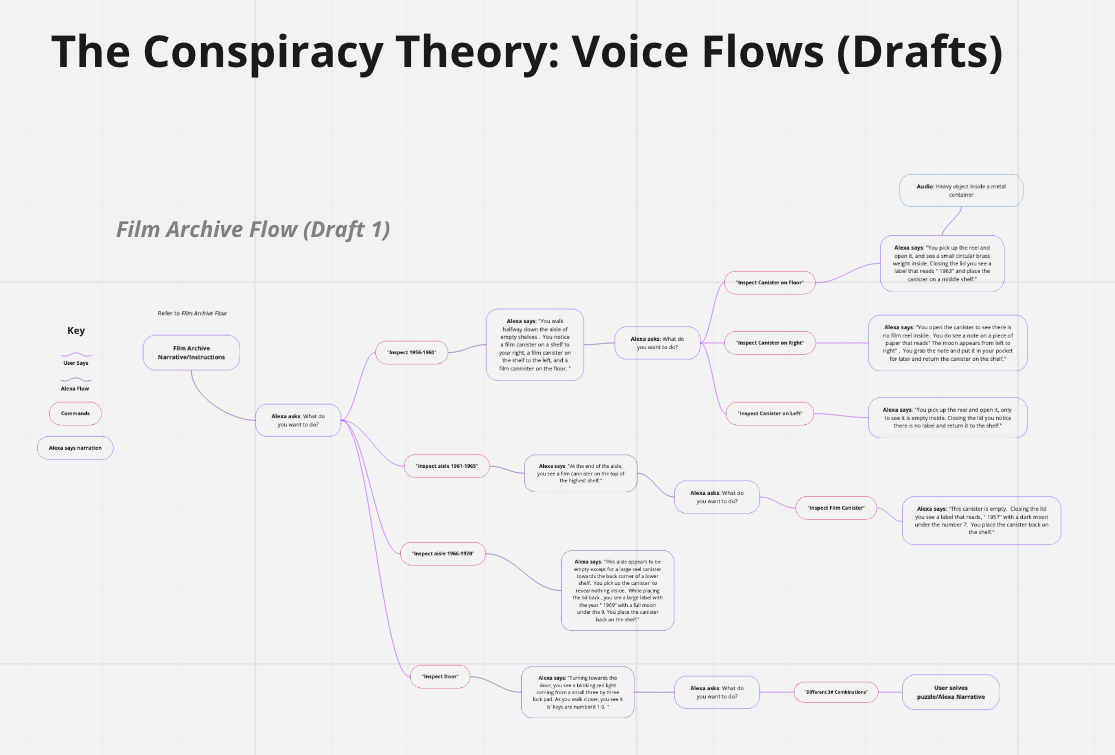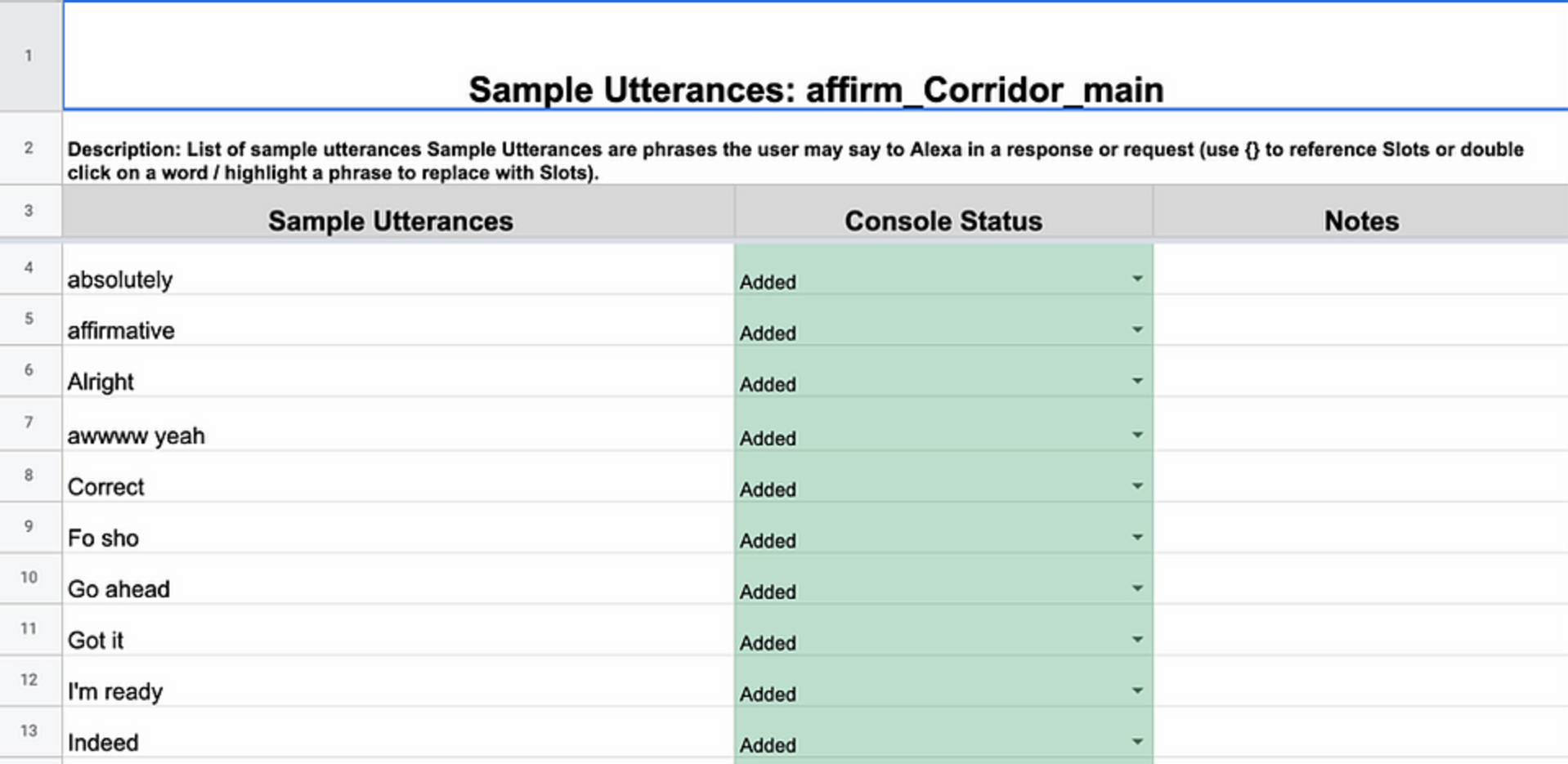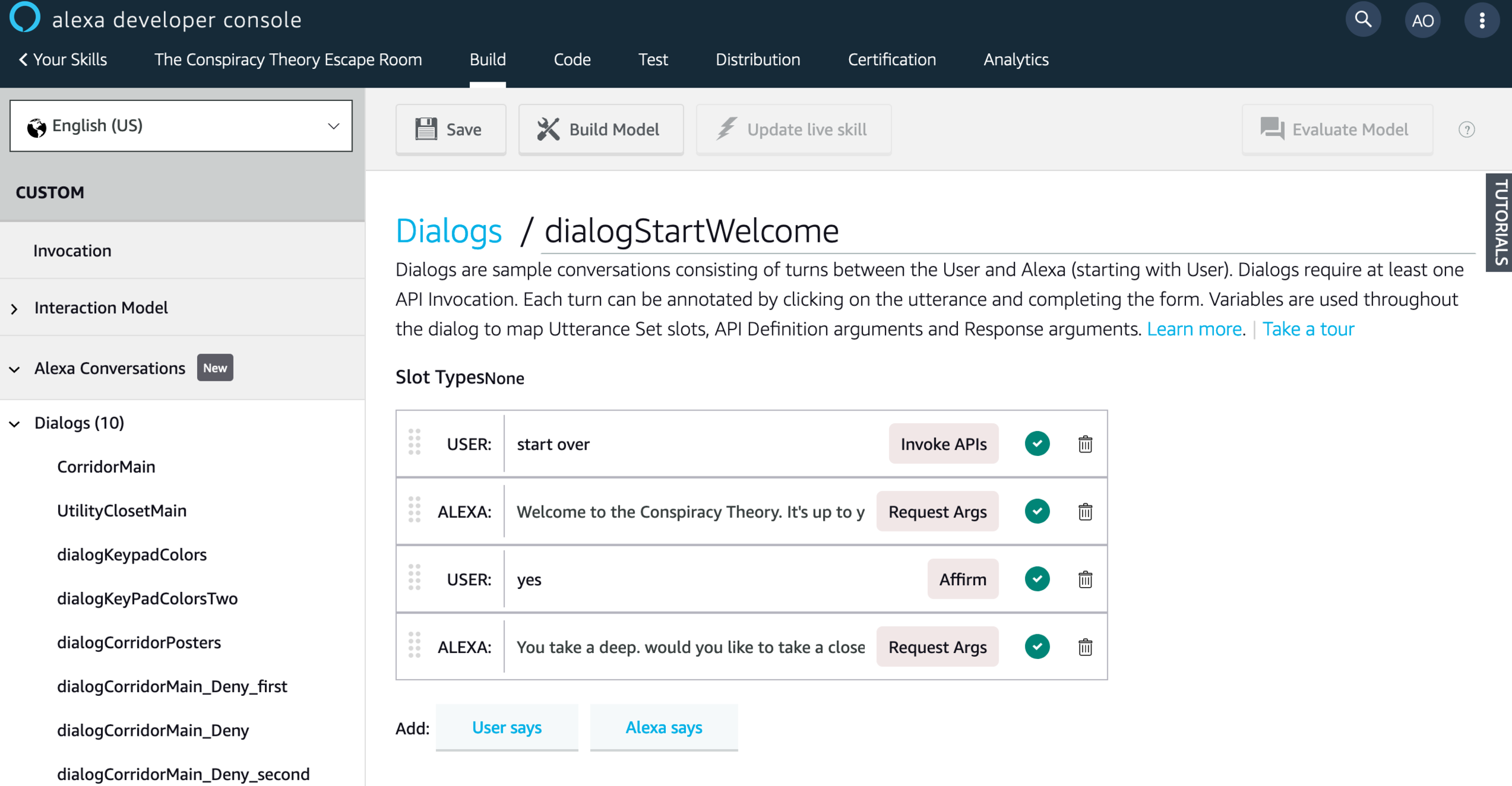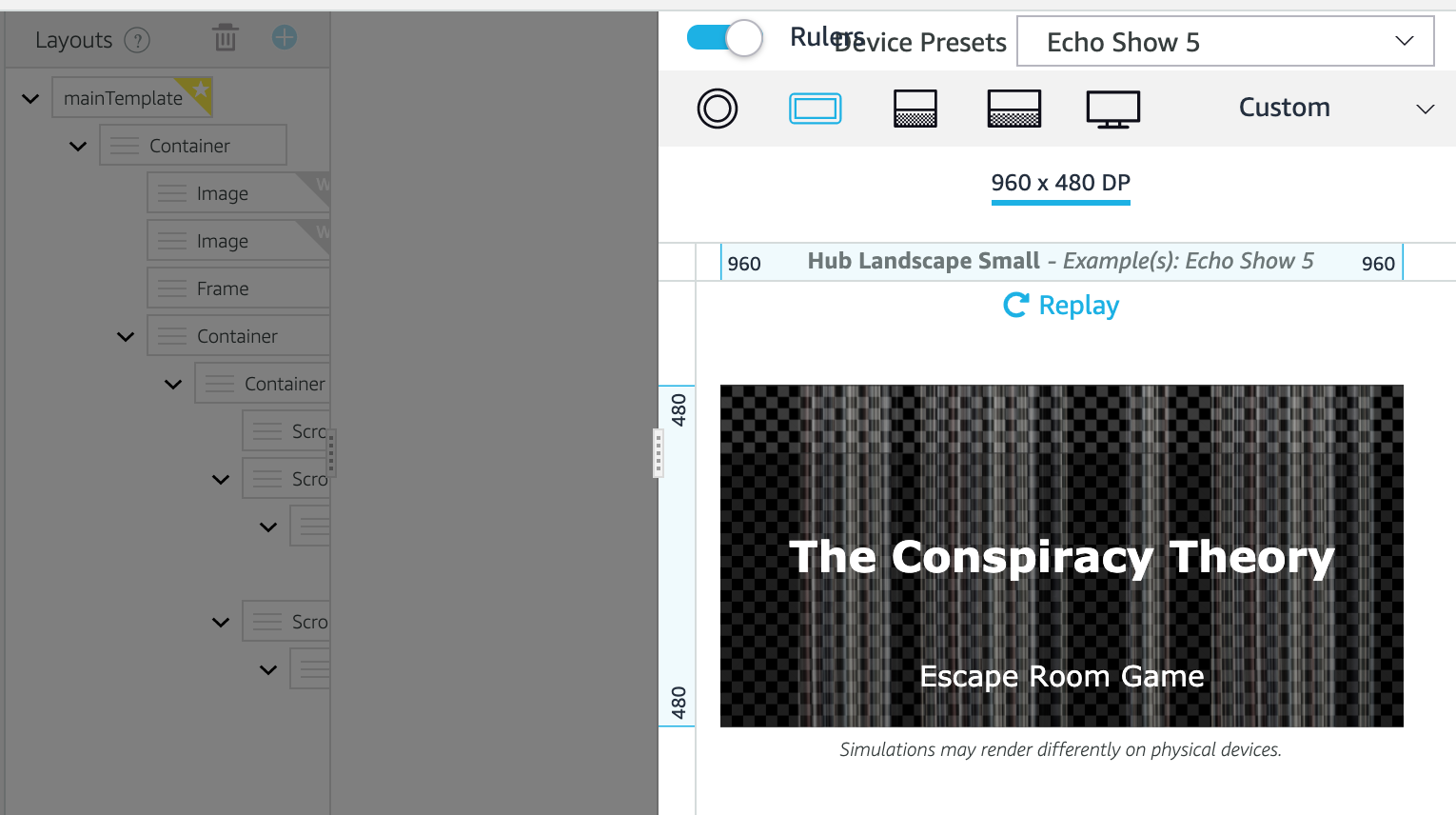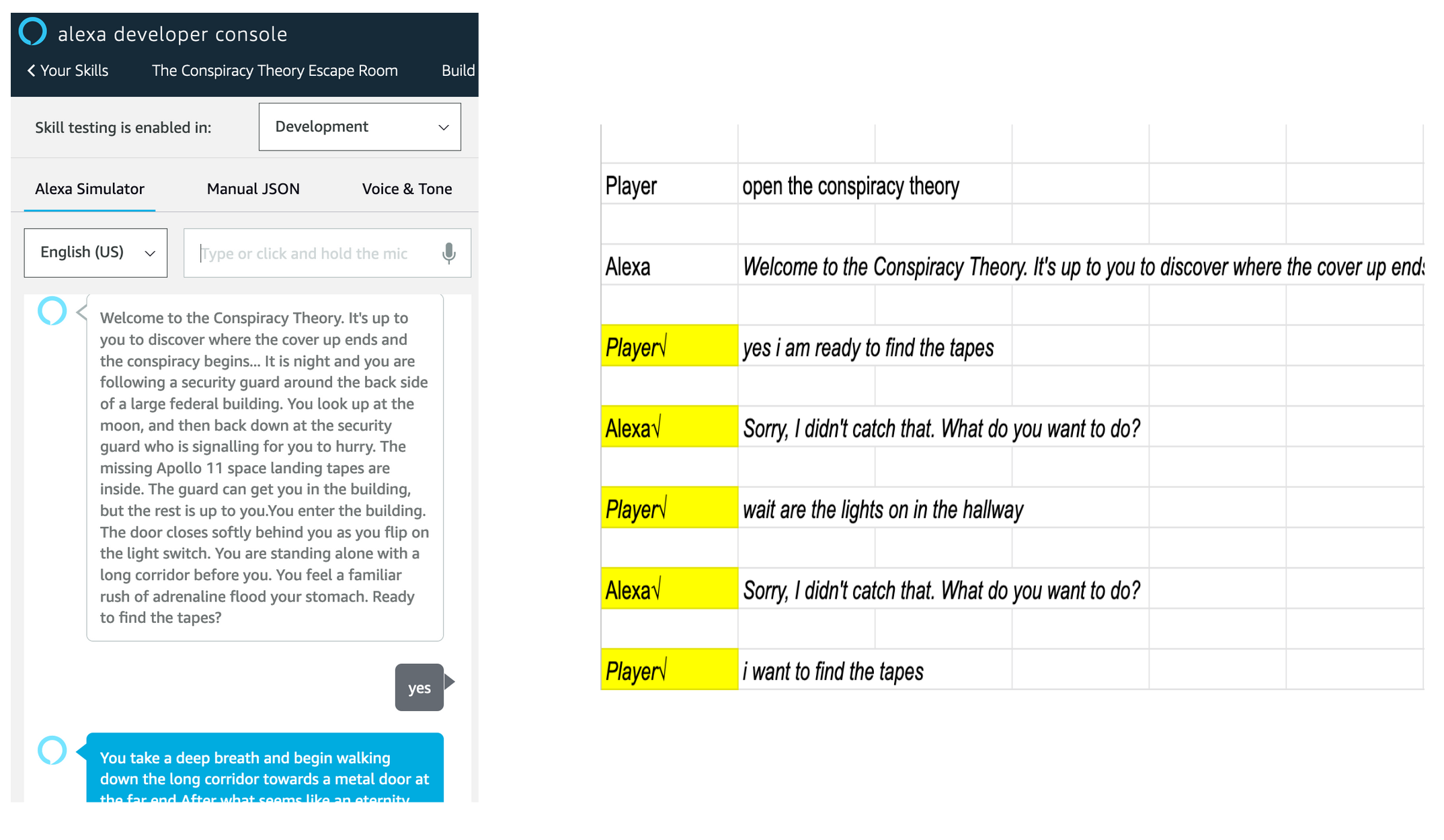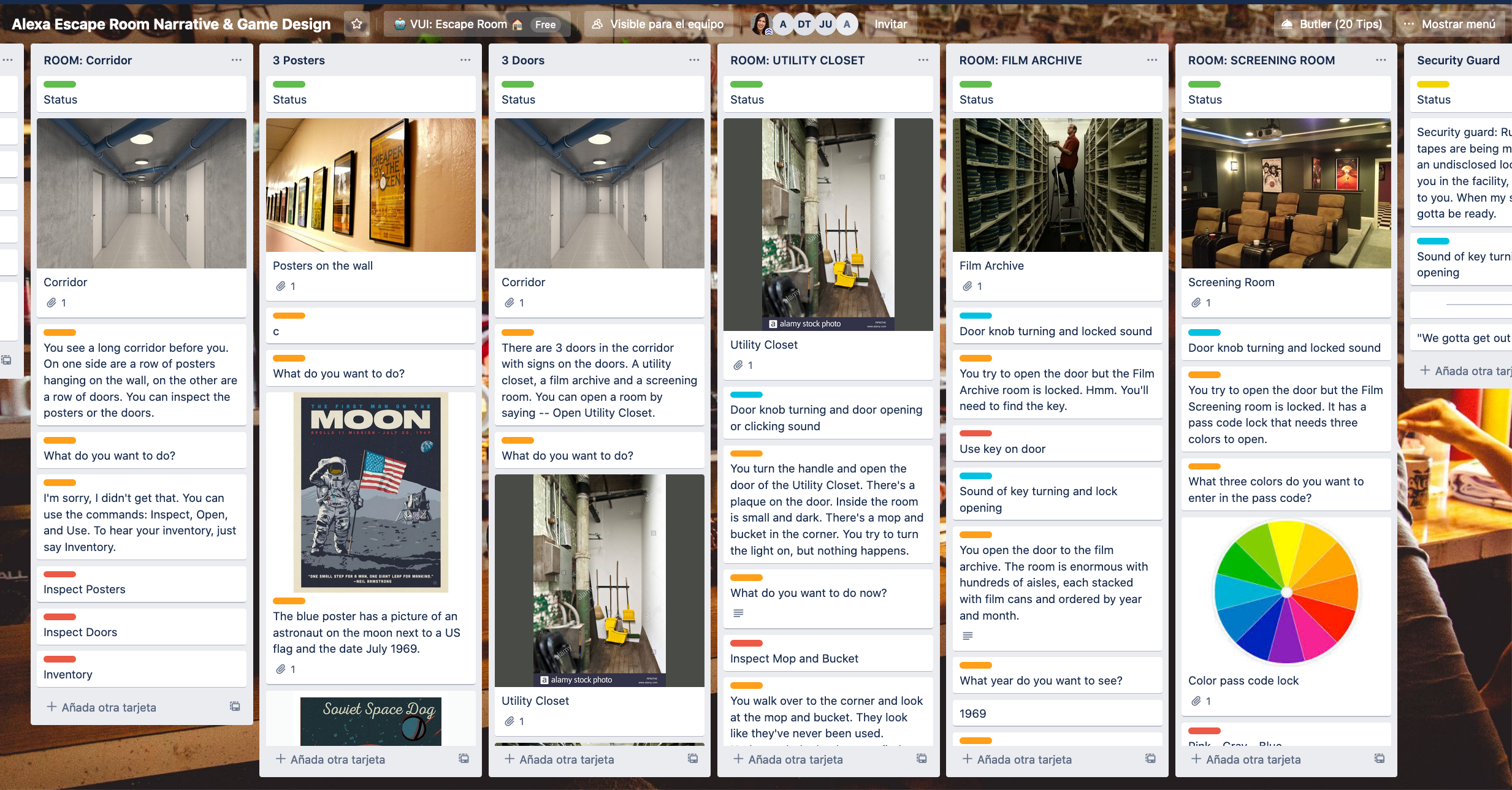
The Conspiracy Theory
Project Case Study
Project Management
The Team
The success of this project was driven by an amazing six member team and a network of seasoned mentors. I began the project brainstorming with my brother, then serendipitously encountered Danno and Jessi in a course on Conversation Design, and met Vicente and Ethel through voice-first developer Slack channels.
Amy Dolin Oliver - Product Management, Conversation Design
Andrew Oliver - Concept Design, Sound Design
Dannon Tabing - Conversation Design, Game Design, Information Architecture
Ethel González - Alexa Skills Developer
Jessi Willey - Conversation Design, Game Design, Multimodal/UI Design
Vicente Gerardo Guzmán Lucio -Alexa Skills Developer, Marketing
Communications
Our team had never met each other, was located in three countries, four different time zones and worked in two different languages. Therefore, communication and resource access was critical.
My first task was to get everyone aligned on the project goals, offer roles, put an agile work framework in place and give everyone shared access to resources (Slack, Trello, Miro, Google Drive, Devpost, Alexa Console). I used a mix of Lean Startup + Design Thinking + Agile-Kanban-Scrum practices, with an eye on Systems Thinking and Exponential Organizations.
The Work
Phase I: MVP
We worked intensively for two weeks with daily stand-ups and autonomous work done asynchronously. At the end of this period we had our first MVP, a one room escape room game and a submission package for Amazon’s Alexa Skills hackathon challenge posted on Devpost. We submitted our game to the Alexa Skill Store for certification, held a team retrospective and rested.
Phase II: Top 10 Finalist
Our game was selected as a top 10 finalist which pushed us into a 10-day iteration sprint and introduced us to Steve, our Amazon project coach. Our goal was to improve the game by 20%.
In this new release, we built a richer audio experience full of sound effects and suspenseful background noises and created responsive, custom made images to create a brooding visually immersive atmosphere. We added additional secondary flows to redirect players towards success and worked around known Alexa Conversations bugs, such as closing the game.
Amazon selected our game for Best Alexa Conversations Audio Skill.
Phase III: Opening the Next Room
We are currently slated to begin third round iterations to remove bugs, incorporate new usabiltity testing feedback, improve visuals on the multimodal side and create a workaround to a technical limitation (lack of containers in Alexa Conversations) preventing us from opening up further rooms.
Design and Development
The Concept
Aliens, the assassination of JFK and Covid-19 conspiracies. That’s where this project started.
I knew I wanted to create a voice-first design and at the time was obsessed with Rusty Lake’s surreal escape room universe. My brother Andrew was wrapped up in understanding conspiracies, one part exploring the unknown but mostly fascinated by fanatic followers.
We settled on the moon landing, a conspiracy remote in time but currently disputed by 6-10% of Americans.
Strategy
Every project has to answer questions about who the intended audience is, what problem or job to be done (JTBD) is being addressed and what the goals of the business are. After researching the market and talking with game players, I made these assumptions and decisions:
Users: adults, English speakers in the US and worldwide, low to mid level game skills, escape room players
User JTBD: enjoy self, relax, spend time with friends/family playing together, be mentally stimulated, feel satisfaction, experience novelty, be immersed in an experience
Business goals: compete in hackathon, develop brand reputation, develop professionally in voice-first industry
Social goals: activate and sharpen critical thinking skills, fight fake news with fact based information
Phase I Research
I researched requirements and constraints on the internet, met with project mentors, talked to game players and consulted with the team. Danno and Jessi investigated other Alexa escape room games while Ethel and Vicente scoured blogs and forums for information on developing with the beta version of Alexa Conversations.
Game Design
To keep the design and developer sides of the team aligned and to facilitate communication, we relied on storyboards and game flows.
In the early stages we considered puzzles that required the player to leave the game and search the internet for answers (ie opening a code with the year the Soviets first launched into space). During concept exploration conversations, gamers steered us (ok, more like incredulously rebuked us) to keep the player inside the game.
The game also went on a series of diets to reduce complexity and difficulty. Our multi-room game became a corridor funnel, we eliminated inventories, and ultimately produced a sizzle reel first installment.
Happy Path Design
I wrote many of the initial dialogues and flows to create the Happy Path and variant secondary paths. Jessi and Danno then designed and wrote on top of these layers, improving the story and taking it in new directions. I later reviewed all dialogues for voice uniformity and used the “Text to Voice” Skill by Top Voice Apps on the entire game to check dialogue musical flow before green lighting it for the developers.
Danno created voice flows to guide the developers, then developed a robust library of sample utterances with over 400 variants.
Image and Audio Design
As this was a voice-first product, careful thought went into creating sound ambiance and audio based puzzles.
Andrew created original audio compositions and sourced from Nasa and the Amazon sound library. One challenge he faced was timing the audio with the exact duration of the dialogues and equalizing volume levels.
Meanwhile Jessi handled the branding and multimodal image creation, designing responsive, custom images with a retro-vintage style. The first branding ideas were influenced by Stranger Things color palette.
Alexa Console
The Interaction Model
Ethel and Vicente got to work using the Happy Path and voice flows to set up intents, sample utterances and slots in the Console.
There was a flurry of back and forth work as they requested the game privacy policy, terms of use link, short and long game descriptions, images for the home screen plus small and large skill icons. Some of the smallest decisions, for example choosing “The Conspiracy Theory” over “Conspiracy Theory”, took a while to decide.
Writing the Code
They coded in Node.js, integrating the Alexa Conversations dialog manager, Alexa Presentation Language, Language for Audio, Speech Synthesis Markup Language and Alexa Emotions. Hosting was handled by AWS Lamda.
Certification
On the days leading to submitting for certification, Ethel and I worked on the phone “side by side” inside the bug log and Happy Path while the rest of the team jumped on tasks as they came up.
We never passed certification on the first try. We would get the failure email, then buckle down and address the flagged errors and resubmit. With each game iteration we got better at this, and experimented with new workflows.
Usability Testing
I ran two periods of usability testing between certifications with ten players. These were 20 minute recorded sessions held in Wizard of Oz fashion where I controlled responses from the Alexa console. Insights and bugs were incorporated into the bug log and discussed during the Retrospectives.
Solving Roadblocks
Consistency: Aligning Dialogues, Audio and Images
One roadblock we had to address was inconsistency across the different dialogues, images and audio content assets.
For example, in one of the game scenes you enter a room with a choice to go over to a second door on the other side of the room. The narrator says, “You cross the room and try the metal door, but it's locked. You notice it has a keypad with a flashing red light and appears to need a three color code to open.” The audios contained the keypad beeping and a push bar door sound effect. However, the visuals showed a room with only one door, no keypad and a door handle doorknob.
The root of the problem was a lack of detail in the spec work and each designer having a different game reality in their heads. This led to lost time in reviews and work needing to be redone. A fast fix was to add guiding images to the storyboard and to suspend reality for questions like— can a color coded keypad even exist?
“Finish script testing before image and audio design. Have conversation designer, image designer and audio designer nail down the details together before passing anything to developers.”
Technical Limitations
Using Alexa Conversations (beta) versus Alexa Skills allowed us to reduce code writing by 70%, however it also introduced new roadblocks.
We all believed we would be using a conversation design platform like Botmock or Botsociety to pass work between the designers and developers. Unfortunately, as Alexa Conversations is a beta version, integration did not exist. I took Hillary Black’s Google Sheets chatbot design template and with her kind permission converted it into a voice design template we called the Happy Path. This document stored all dialogues, images, audios and divergent paths. This, paired with voice flow drawings in Miro, solved that need.
Another problem we faced was the Alexa Console only supported one developer working in it at a time, otherwise the other developer’s work would be deleted during deployment. Compounding this problem, no version control existed. More than a few times, we lost hours of code while racing for deadlines.
Central to the core of our game, Alexa Conversations didn’t have a way to close a conversation nor to create containers which would wall off one room from another.
To work around the game ending, I wrote two conversation paths: one which started the game again and another which used an Alexa designated word to kick the player out of the skill.
The container problem remains unsolved. The AI-driven approach to dialogue management causes the player to be “thrown” from one room back to a previous one. We plan to address it in Phase III.
“Sleep well the weekend before scheduled deployments.”
Successes
Selected as a Top 10 Finalist and Best Audio in Alexa Conversations Challenge
Great team rapport. We trusted each other and got the work done, on deadline.
The team was supportive, cooperative, quick on pivots, good at giving and receiving feedback, and was very diverse in background and skill sets.
Validation from the greater conversation design and developer community

